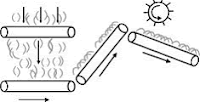-->
-->
Nonwoven Fabrics
Techniques by which fabrics are made directly from fibers, bypassing both spinning and weaving, have been used for centuries in the production of felt and bark cloth is called nonwoven fabric. It is also called nonwoven geotextile fabric because it is one kinds of geotextile. With the development of manufactured fibers, and, in particular, the synthesis of thermoplastic fibers, technologies have evolved that have made possible the large-scale production of non-woven fabrics. The first non-woven consumer product, an interlining fabric for the apparel industry, was introduced in 1952. Marketed extensively for both durable and disposable items, nonwoven fiber webs range from disposable diapers to blankets, from industrial filters to tea-bag covers.
Nonwoven fabrics are textile structures “produced by bonding or interlocking of fibers, or both, accomplished by mechanical, chemical, thermal or solvent means and combinations thereof” (ASTM 1998). This excludes fabrics that have been woven, knitted, or tufted. The Association of the Nonwovens Fabrics Industry (lNDA) in the United States and the European Disposables and Nonwovens Association (EDANA) help to further define what may be called a nonwoven fabric Oirsak and Wadsworth 1999). Over 50 percent of the weight of a non woven must be comprised of fibers with an aspect ratio (length to diameter ratio) of 300. This excludes paper products that are normally made of extremely short fibers. In additi”on nonwovens must have a density less than 0.4 grams per cubic centimeter, and felted fabrics are usually much heavier.
American Fabrics (1974) magazine recommended that nonwoven fabrics be classified as durable products or disposable products. They defined a durable product as “one which is multi-use. It is not manufactured to be thrown away after a single application” (p. 40). Examples of this type of product are blankets, carpet backings, and furniture padding. Disposable products were defined as “made to be disposed of after a single or limited number of uses”. These are exemplified in disposable diapers, towels, or tea-bag covers. American Fabrics pointed out that some items are disposable not because of their durability but because of their purpose. Medical gowns, for example, or airplane and train headrests, might withstand multiple use, but for sanitary reasons they have limited use periods.
Manufacture of nonwoven fabric
There are two steps involved in manufacturing nonwoven fabrics:
(1) preparation of the fiber web and
(2) bonding of the fibers in the web.
A number of possibilities exist for each step, and in addition, the two stages may be distinct or can be carried out as a more or less continuous process.
Fiber Web Formation Staple fiber webs are produced by either dry firming or wet firming. Dry-forming processes are carding, also called dry laying, and air laying. Carded webs are made in a manner similar to the process for felt webs and slivers for yarn spinning. Thicker webs can be built up by layering the carded webs. In air laying, the fibers are opened, suspended by air, and then collected on a moving screen. The wet laid process is similar to paper making in that a mixture of fibers in water is collected on a screen, drained, and then dried.
Webs can also be made by the direct extrusion processes of spunbonding and melt blowing. Spunbonded fabrics are manufactured from synthetic filament fibers. Continuous filaments are formed by extrusion through spinnerets, and the filaments are blown onto a moving belt where they form a web. As the still hot and partially molten filaments touch, they bond. Polymers most often used are polypropylene and polyester. Spun bonded fabrics are strong because of the filament fibers and are not easily torn. They are used for a wide variety of products ranging from apparel interlinings, carpet backing, furniture and bedding to bagging and packing material. Spunbonded fabrics may be used in geotextiles to control erosion or in constructing roads.
Some spun bonds made from olefins are used as a tough, especially durable substitute for paper in wall coverings, charts, maps, tags, and the like. Melt blowing also forms fabrics directly from fibers, but it differs from spun bonding in that molten fiber filaments are attenuated and broken into short lengths as they exit from the spinnerets. Cool air distributes the fibers onto a moving screen.
As the fibers cool they bond, forming a white, opaque web of fine fibers. Because the fibers in melt-blown nonwovens are fine, the fabrics make good filter materials. Specialty products can also be made by layering spun bonded and melt blown fabrics or by entrapping absorbent fibers or other materials within the melt blown structure.













